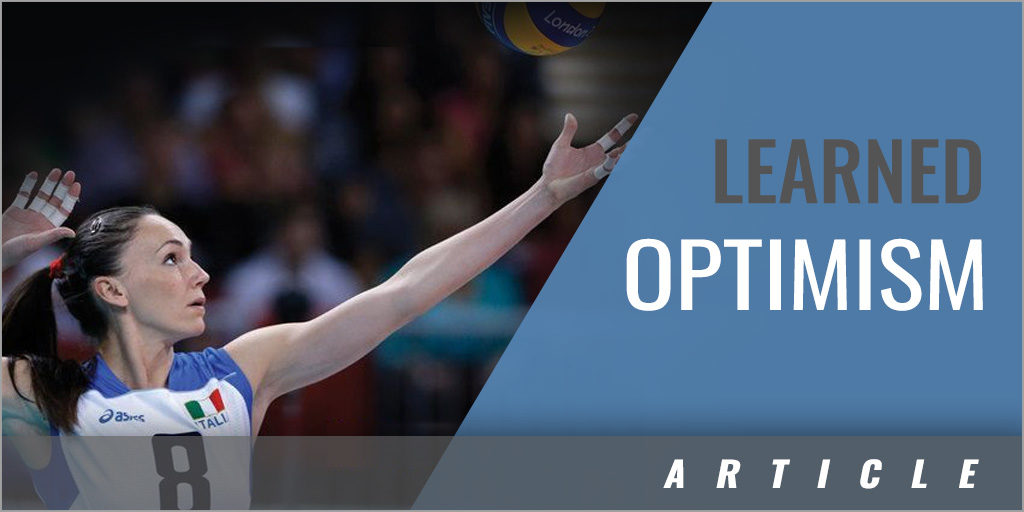|
By: Mike Hebert Originally Published in: Thinking Volleyball Provided by: Human Kinetics For those of us who had become skeptical of the power of positive thinking (repeating affirmations and visualizations to oneself) as the road to personal and team success, learned optimism provided a way to take our pursuit to the next level. The following is an outline of some of the fundamental ideas contained in Seligman's book Learned Optimism: When we fail at something, we all become helpless and depressed at least momentarily. We don't initiate voluntary actions as quickly as we would otherwise, or we may not try at all. If we do try, we will not persist. Explanatory style is the great modulator of learned helplessness. Optimists recover from their momentary helplessness immediately. Very soon after failing, they pick themselves up, shrug, and start trying again. For them, defeat is a challenge, a mere setback on their road to inevitable victory. They see defeat as temporary and specific, not pervasive. Pessimists wallow in defeat, which they see as permanent and pervasive. They become depressed and stay helpless for very long periods. A setback is a defeat. And a defeat in one battle is the loss of the war. They don't begin to try again for weeks or months, and if they try, the slightest new setback throws them back into a helpless state.* One of the main sources of negative thinking that can lead to poor performance is learned helplessness. This is giving up, the quitting response, the belief there is nothing I can do. Learned helplessness is at the core of failure and defeat. There are two major risk factors for poor achievement among athletes:
As coaches we must do our homework. Careful observation of each player will provide the coach with enough information to make the correct evaluation. Learn to recognize the automatic thoughts (phrases, sentences) running through a player's mind when things are going badly. The player may not notice these thoughts. Teach players to dispute these automatic thoughts by thinking of contrary evidence. Players must learn to create different explanations to dispute automatic thoughts, distract themselves from pessimistic thoughts, and recognize and question the pessimistic assumptions governing much of what they do. There are three basic predictions for sports. First, everything else being equal, the individual with the more optimistic explanatory style will go on to win. She will win because she will try harder, particularly after defeat or under stiff challenge. Second, this prediction holds for teams. If a team can be characterized by its level of optimism, the more optimistic team will win - if talent is equal; this phenomenon will be most apparent under pressure. Third, and most exciting, when athletes' explanatory style is changed from pessimistic to optimistic, they will win more, particularly under pressure. Key Insights From Practicing
Here is what Seligman recommends to coaches. We must take these findings seriously. They have several immediate, practical implications for us.
There are several ways for players to overcome the negative spiral caused by pessimism. First, distract yourself when pessimistic thoughts occur. Stop ruminating and shift your attention; this is an important concept. Schedule a later time to review the situation. You also can dispute the evidence. Ask yourself, "What is the evidence for this belief?" One way to dispute a negative belief is to show that it is factually incorrect. For example, a player believes "I suck as a passer." What evidence is there for this belief? Imagine she can tell herself: "The truth is I've passed thousands of balls to the target. I just shanked one ball. There is a strong likelihood that my next pass will be closer to the target. I know this because I've proven myself as a passer in the past." A second way to dispute a pessimistic thought is to scan for alternative causes of the event. Most events have multiple causes. Rarely is anything as simple as "I suck." For example, a player says "I didn't put a very good move on that last ball. But other factors were at work as well. I was up against the opponent's toughest server. I'm also passing next to a teammate who is very quiet and does not clarify passing responsibilities as she should. This situation may have created momentary tentativeness for me as I attempted to pass that last ball. Not only that, I've been having a tough time passing the deep ball and getting to the net to get a swing at our low outside set. I just hurried that last pass and let it get away. These are all correctable things, and there is no reason to believe I will let them affect my next attempt. I choose to focus on the things I can change in this situation." A third way to dispute a pessimistic thought is to minimize the severity of the event. Maybe you are not the best passer on the team. Maybe you are prone to making errors. So what? There is no need to conclude that this is a catastrophic event. See it for what it is and move on. For example, a player may say, "Yeah I blew that one. And the likelihood of getting served again is high. But so far I've only given up this one point. This is not a catastrophe. No need to conclude that I'll shank the next one. Let's bear down here and put a better move on the ball." A fourth way to dispute a pessimistic thought is to ask if your belief, even if true, is functional for you in the present situation. Instead of disputing your pessimistic thought, ask if your belief is helping you in facing your adversity. This is especially true when, as an athlete, you have to perform now. Distraction (not disputation) might be the tool of choice. For example, a player may say, "Even the stats show that I am not a good passer. It is not unreasonable to believe that I might shank the next ball as well. But since there is a good chance that I will be served again, I've got to distract myself right now and turn to optimistic thoughts about the next pass. I'll say to myself, 'Stop!' and I'll assign a later time to worry about my passing." Learning to be an optimist in sports is a difficult assignment. For the pessimist, it might require reversing a lifetime of negative thinking. The more quickly you can rid your players of the pessimism that can engulf a team if left unchecked, the more quickly you can launch your plan to add learned optimism to your list of trust-building skills. References *Martin E.P. Seligman, Learned Optimism (New York: Alfred A. Knopf, 1998), 137. |






